How to Visualize Evenly Spaced Xticks Despite Their Value in Matplotlib
Visualizing xticks evenly spaced despite their value in Matplotlib is a crucial skill for data visualization enthusiasts and professionals alike. This article will delve deep into the intricacies of creating evenly spaced xticks in Matplotlib, regardless of the underlying data values. We’ll explore various techniques, best practices, and provide numerous examples to help you master this essential aspect of data visualization.
Understanding the Importance of Evenly Spaced Xticks
Before we dive into the specifics of visualizing xticks evenly spaced despite their value in Matplotlib, it’s essential to understand why this technique is so important. Evenly spaced xticks can greatly enhance the readability and interpretability of your plots, especially when dealing with data that has irregular intervals or non-linear relationships.
When visualizing xticks evenly spaced despite their value, you’re essentially creating a visual representation that prioritizes the uniform distribution of labels along the x-axis, rather than adhering strictly to the numerical values of the data. This approach can be particularly useful in scenarios where:
- You’re dealing with categorical data that doesn’t have a natural numerical order.
- You want to emphasize the relative positions of data points rather than their absolute values.
- You’re working with time series data that has irregular intervals.
- You need to compare multiple datasets with different scales or ranges.
Let’s start with a simple example to illustrate the concept of visualizing xticks evenly spaced despite their value in Matplotlib:
import matplotlib.pyplot as plt
import numpy as np
# Sample data
x = [1, 5, 10, 50, 100]
y = [2, 4, 6, 8, 10]
# Create the plot
plt.figure(figsize=(10, 6))
plt.plot(x, y, marker='o')
# Set evenly spaced xticks
plt.xticks(range(len(x)), x)
plt.title("Visualizing Xticks Evenly Spaced Despite Their Value - how2matplotlib.com")
plt.xlabel("X-axis")
plt.ylabel("Y-axis")
plt.grid(True)
plt.show()
Output:
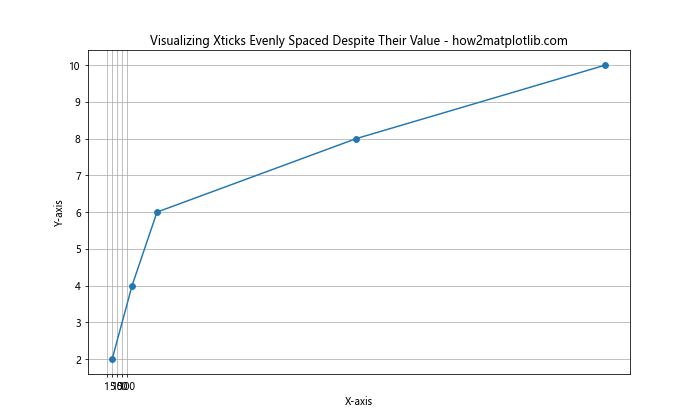
In this example, we’ve created a simple line plot with unevenly spaced x-values. By using plt.xticks(range(len(x)), x), we’ve managed to visualize xticks evenly spaced despite their value in Matplotlib. The xticks are now evenly distributed along the x-axis, even though the actual values (1, 5, 10, 50, 100) are not evenly spaced.
Techniques for Visualizing Xticks Evenly Spaced Despite Their Value
Now that we understand the basics, let’s explore various techniques for visualizing xticks evenly spaced despite their value in Matplotlib. We’ll cover several approaches, each with its own advantages and use cases.
1. Using plt.xticks() with Custom Positions
One of the most straightforward methods for visualizing xticks evenly spaced despite their value in Matplotlib is to use the plt.xticks() function with custom positions. This approach allows you to explicitly define the positions and labels of your xticks.
import matplotlib.pyplot as plt
import numpy as np
# Sample data
x = [0, 10, 50, 100, 500, 1000]
y = np.random.randint(1, 100, len(x))
# Create the plot
plt.figure(figsize=(12, 6))
plt.plot(x, y, marker='o')
# Set evenly spaced xticks
plt.xticks(range(len(x)), x)
plt.title("Evenly Spaced Xticks with Custom Positions - how2matplotlib.com")
plt.xlabel("X-axis (log scale)")
plt.ylabel("Y-axis")
plt.grid(True)
plt.show()
Output:
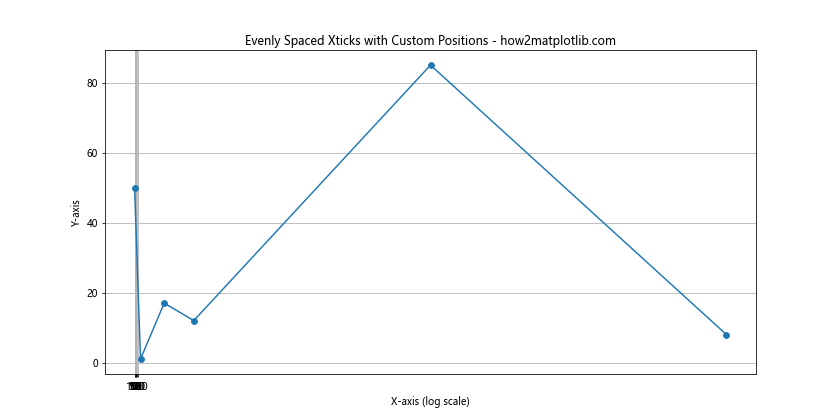
In this example, we’ve used plt.xticks(range(len(x)), x) to create evenly spaced xticks despite the logarithmic nature of the x-values. This technique is particularly useful when visualizing xticks evenly spaced despite their value in scenarios where the data points are not uniformly distributed.
2. Using ax.set_xticks() and ax.set_xticklabels()
Another powerful method for visualizing xticks evenly spaced despite their value in Matplotlib is to use the ax.set_xticks() and ax.set_xticklabels() functions. This approach gives you more fine-grained control over the placement and labeling of your xticks.
import matplotlib.pyplot as plt
import numpy as np
# Sample data
x = [1, 10, 100, 1000, 10000]
y = [2, 4, 6, 8, 10]
# Create the plot
fig, ax = plt.subplots(figsize=(12, 6))
ax.plot(x, y, marker='o')
# Set evenly spaced xticks
ax.set_xticks(range(len(x)))
ax.set_xticklabels(x)
ax.set_title("Evenly Spaced Xticks with set_xticks and set_xticklabels - how2matplotlib.com")
ax.set_xlabel("X-axis (log scale)")
ax.set_ylabel("Y-axis")
ax.grid(True)
plt.show()
Output:

This example demonstrates how to use ax.set_xticks() and ax.set_xticklabels() to achieve evenly spaced xticks despite the logarithmic nature of the x-values. This method is particularly useful when visualizing xticks evenly spaced despite their value in more complex plots or when you need to customize the tick labels further.
3. Using LinearLocator for Evenly Spaced Ticks
When visualizing xticks evenly spaced despite their value in Matplotlib, the LinearLocator class can be a powerful tool. It allows you to specify the number of ticks you want, and Matplotlib will automatically distribute them evenly across the axis.
import matplotlib.pyplot as plt
import numpy as np
from matplotlib.ticker import LinearLocator
# Sample data
x = np.logspace(0, 4, 5)
y = np.random.randint(1, 100, len(x))
# Create the plot
fig, ax = plt.subplots(figsize=(12, 6))
ax.plot(x, y, marker='o')
# Set evenly spaced xticks using LinearLocator
ax.xaxis.set_major_locator(LinearLocator(numticks=5))
ax.set_xticklabels([f"{int(tick)}" for tick in ax.get_xticks()])
ax.set_title("Evenly Spaced Xticks with LinearLocator - how2matplotlib.com")
ax.set_xlabel("X-axis (log scale)")
ax.set_ylabel("Y-axis")
ax.grid(True)
plt.show()
Output:
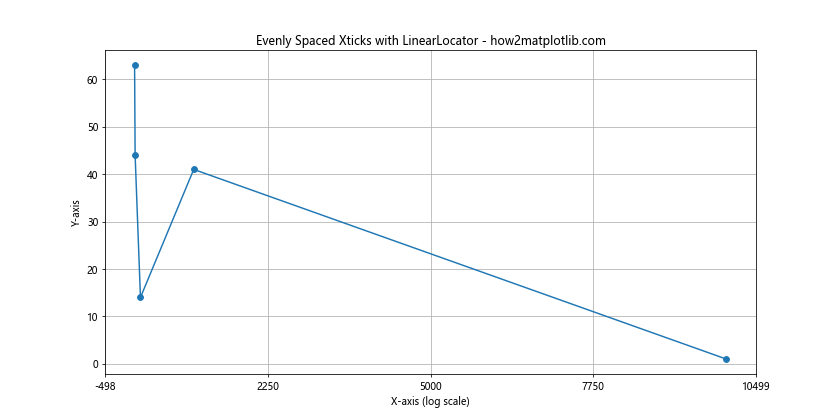
In this example, we’ve used LinearLocator to create evenly spaced xticks despite the logarithmic nature of the x-values. This method is particularly useful when visualizing xticks evenly spaced despite their value in scenarios where you want to maintain a consistent number of ticks regardless of the data range.
Advanced Techniques for Visualizing Xticks Evenly Spaced Despite Their Value
Now that we’ve covered the basics, let’s explore some more advanced techniques for visualizing xticks evenly spaced despite their value in Matplotlib. These methods will help you handle more complex scenarios and create even more polished visualizations.
4. Handling Date and Time Data
When visualizing xticks evenly spaced despite their value in Matplotlib, dealing with date and time data can be particularly challenging. Here’s an example of how to handle this scenario:
import matplotlib.pyplot as plt
import numpy as np
from datetime import datetime, timedelta
import matplotlib.dates as mdates
# Generate sample date data
start_date = datetime(2023, 1, 1)
dates = [start_date + timedelta(days=i*30) for i in range(6)]
y = np.random.randint(1, 100, len(dates))
# Create the plot
fig, ax = plt.subplots(figsize=(12, 6))
ax.plot(dates, y, marker='o')
# Set evenly spaced xticks for dates
ax.xaxis.set_major_locator(mdates.AutoDateLocator())
ax.xaxis.set_major_formatter(mdates.DateFormatter('%Y-%m-%d'))
ax.set_title("Evenly Spaced Xticks for Date Data - how2matplotlib.com")
ax.set_xlabel("Date")
ax.set_ylabel("Value")
ax.grid(True)
plt.xticks(rotation=45)
plt.tight_layout()
plt.show()
Output:

In this example, we’ve used mdates.AutoDateLocator() and mdates.DateFormatter() to handle date data when visualizing xticks evenly spaced despite their value. This approach automatically selects appropriate date intervals and formats the labels accordingly.
5. Handling Categorical Data
Visualizing xticks evenly spaced despite their value in Matplotlib is particularly useful when dealing with categorical data. Here’s an example of how to handle categorical data with evenly spaced xticks:
import matplotlib.pyplot as plt
import numpy as np
# Sample categorical data
categories = ['Apple', 'Banana', 'Cherry', 'Date', 'Elderberry']
values = np.random.randint(1, 100, len(categories))
# Create the plot
fig, ax = plt.subplots(figsize=(12, 6))
ax.bar(range(len(categories)), values)
# Set evenly spaced xticks for categories
ax.set_xticks(range(len(categories)))
ax.set_xticklabels(categories)
ax.set_title("Evenly Spaced Xticks for Categorical Data - how2matplotlib.com")
ax.set_xlabel("Fruit")
ax.set_ylabel("Value")
ax.grid(True, axis='y')
plt.tight_layout()
plt.show()
Output:
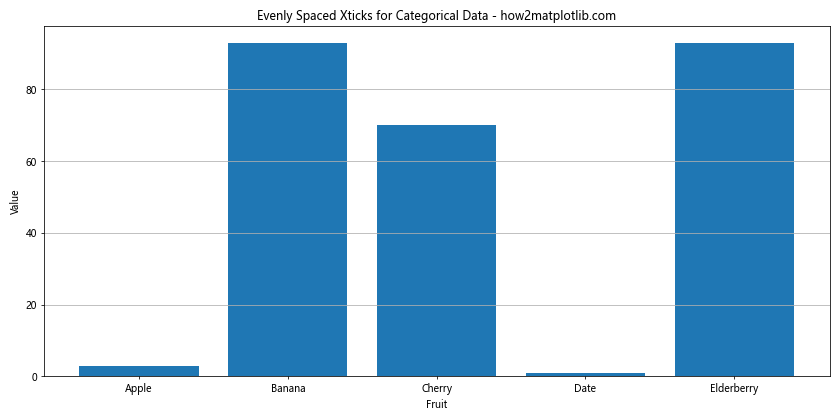
This example demonstrates how to create a bar plot with evenly spaced xticks for categorical data. By using range(len(categories)) as the x-values and setting the tick labels to the category names, we achieve evenly spaced xticks despite the non-numeric nature of the data.
6. Handling Logarithmic Scales
When visualizing xticks evenly spaced despite their value in Matplotlib, you might encounter scenarios where you need to work with logarithmic scales. Here’s an example of how to handle this:
import matplotlib.pyplot as plt
import numpy as np
# Sample data with logarithmic scale
x = np.logspace(0, 5, 6)
y = np.random.randint(1, 100, len(x))
# Create the plot
fig, ax = plt.subplots(figsize=(12, 6))
ax.plot(x, y, marker='o')
# Set logarithmic scale for x-axis
ax.set_xscale('log')
# Set evenly spaced xticks for logarithmic scale
ax.set_xticks(x)
ax.set_xticklabels([f"{int(tick)}" for tick in x])
ax.set_title("Evenly Spaced Xticks for Logarithmic Scale - how2matplotlib.com")
ax.set_xlabel("X-axis (log scale)")
ax.set_ylabel("Y-axis")
ax.grid(True)
plt.tight_layout()
plt.show()
Output:
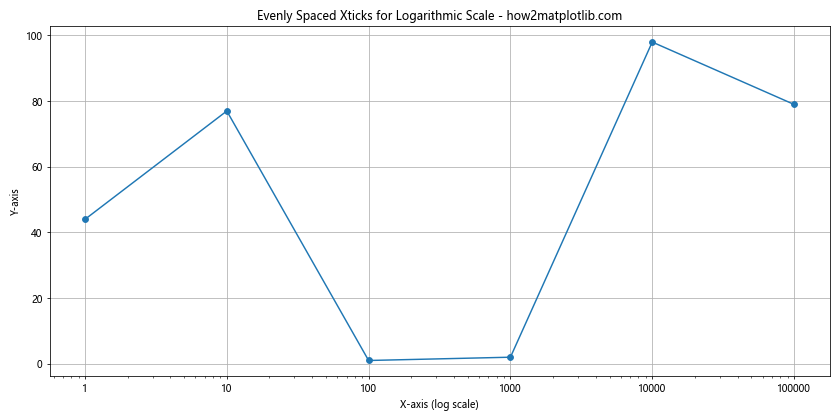
In this example, we’ve used ax.set_xscale('log') to set a logarithmic scale for the x-axis. By manually setting the xticks to our data points and formatting the labels, we achieve evenly spaced xticks despite the logarithmic nature of the data.
7. Handling Multiple Subplots
When visualizing xticks evenly spaced despite their value in Matplotlib across multiple subplots, you need to ensure consistency and readability. Here’s an example of how to handle this scenario:
import matplotlib.pyplot as plt
import numpy as np
# Sample data
x1 = [1, 5, 10, 50, 100]
y1 = np.random.randint(1, 100, len(x1))
x2 = [0, 20, 40, 60, 80, 100]
y2 = np.random.randint(1, 100, len(x2))
# Create the plot with subplots
fig, (ax1, ax2) = plt.subplots(2, 1, figsize=(12, 10))
# Plot for the first subplot
ax1.plot(x1, y1, marker='o')
ax1.set_xticks(range(len(x1)))
ax1.set_xticklabels(x1)
ax1.set_title("Subplot 1 - how2matplotlib.com")
ax1.set_xlabel("X-axis")
ax1.set_ylabel("Y-axis")
ax1.grid(True)
# Plot for the second subplot
ax2.plot(x2, y2, marker='s')
ax2.set_xticks(range(len(x2)))
ax2.set_xticklabels(x2)
ax2.set_title("Subplot 2 - how2matplotlib.com")
ax2.set_xlabel("X-axis")
ax2.set_ylabel("Y-axis")
ax2.grid(True)
plt.tight_layout()
plt.show()
Output:
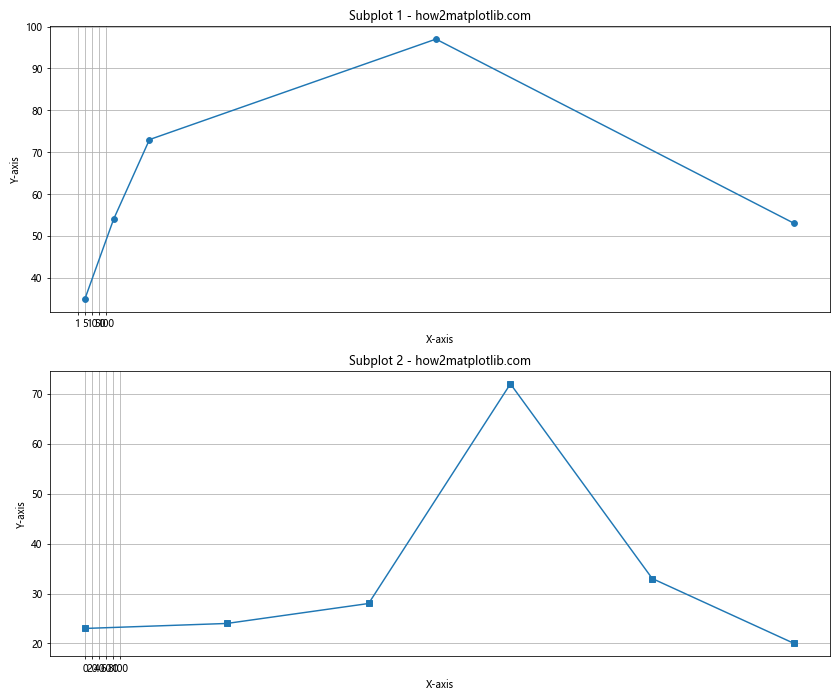
This example demonstrates how to create evenly spaced xticks despite their value across multiple subplots. By using set_xticks() and set_xticklabels() for each subplot, we ensure consistent and readable xticks across the entire figure.
Best Practices for Visualizing Xticks Evenly Spaced Despite Their Value
When it comes to visualizing xticks evenly spaced despite their value in Matplotlib, there are several best practices to keep in mind:
- Consistency: Ensure that your xtick spacing is consistent across all plots in your project or presentation.
Readability: Choose a number of xticks that balances information density with readability. Too many ticks can clutter the plot, while too few may not provide enough context.
Alignment: When using multiple subplots, align the xticks vertically for easier comparison between plots.
Rotation: If your xtick labels are long, consider rotating them to prevent overlap. Use
plt.xticks(rotation=45)or a similar angle.Formatting: Use appropriate formatting for your xtick labels, especially when dealing with large numbers, dates, or percentages.
Grid lines: Consider adding grid lines to make it easier for viewers to trace values back to the axis. Use
plt.grid(True)orax.grid(True).Color and style: Ensure your xtick labels are easily readable against the background. Adjust color and font size as needed.
Scale appropriately: When dealing with large ranges of values, consider using logarithmic scales or breaking the axis.
Let’s explore some more advanced examples that incorporate these best practices while visualizing xticks evenly spaced despite their value in Matplotlib.